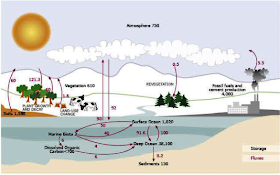Hey peeps! Sry I can’t post as much as Sylvia either.. X)
Heat budget system
The heat budget system is important to earth as it helps to keep us warm, and thus makes earth habitable. Therefore, we cannot live on mars or any other planets because this system (including other cycles) is absent, and hence the planets cannot maintain a suitable temperature.
The heat budget system must be balanced. If not, the earth will either heat up or cool down too much. If it is balanced, there would be a constant temperature.
Shortwave reaches the earth as (1-4microm) ultraviolet light, infrared and light radiation entering the earth’s system. This gets reflected back into space by clouds, air particles and land surfaces. Long wave radiation (longer than about 4 microm) is heat, which becomes either trapped in the atmosphere or lost to space.
30% of the sun’s rays are immediately reflected back into space. 20% heat the earth’s atmosphere, leaving only 50% to heat the land and oceans. If the rays don’t escape to space, the earth would be too hot for humans or animals to survive.
The carbon cycle actually interacts with heat budget. Hence, there is no balance, and the earth heats up. This leads to global warming. This would lead to harm of the environment. For example, polar ice caps would melt with global warming. When polar ice caps melt, the heat budget would also be affected because the ice helps to reflect light. Global warming would also cause strange weather. When the earth heats up, the gas would expand. As a result, it takes up more space and rises. This causes high and low pressure in the air, which results in wind.
Several cycles are present to control the climate on earth.


Heat budget system

Carbon cycle

The water cycle
(sry for the small pictures. the layout of the blog doesn't allow me to post bigger ones. anw, if you cant see clearly, just enlarge the whole thing :))
Some terms:
Latent heat: Energy released or absorbed to change a substance to gas.
Sensible heat: Visible to the naked eye such as steam from a cup of coffee
Albedo: Ability of an object to reflect light and radiation.
-yithan

Hello Yit Han!
ReplyDeleteThanks for your post!:) I was doing some research and I found out about a project conducted on the Arctic Ocean called The Surface Heat Budget of the Arctic Ocean (SHEBA) study. SHEBA was designed to learn more about the exact heat transfer processes that occur between the ocean and the atmosphere over the course of one year in the Arctic Ocean.
The climate in the Arctic is quite different from what we have in most other parts of the world. Of course, it is much, much colder there, because the sun's rays are dispersed over a larger surface area. As a result, the sun is only above the horizon from spring through summer and below the horizon the other six months. It is difficult to imagine spending half a year in perpetual darkness, so it's a miracle that life can still survive there!
As Yit Han explained, albedo is the ability of an object to reflect light and radiation. If you think about it, the colour white (of the snow, which is about all there is in the Arctic) reflects all the other colours (in laymen's terms) and thus, it would reflect a lot of light, meaning that it has a high albedo. (That explains why when people go skiing, they use protective shades, as such bright light can be blinding)
We can also deduce that ice has a higher albedo than ocean water (not because ocean water is unreflective, but because ice is just really reflective). In fact, snow-covered sea ice reflects about 80% of the incident sunlight (which, as you can see from the diagrams Yit Han provided, is the light rays hitting the Earth).
According to Wikipedia, "Seasonal changes in the Arctic result in clear skies and radiational cooling from snow-covered sea ice in the constantly dark arctic winter. In spring, with the return of sunlight, melt pools begin to form and increase the rate of heat absorption from the sun. In the summer, during constant daylight, clouds form which reflect light to the sky, but impede heat flow from the ocean."
Hence, the scientists of SHEBA measured the following: longwave and shortwave radiative fluxes, the turbulent fluxes of latent and sensible heat, cloud height, thickness and other properties, processes of energy exchange in the boundary layers of the atmosphere and ocean, snow depth and ice thickness and lastly, ocean salinity, temperature, and currents.
The results were as follows:
Clouds are prevalent throughout the year in the Arctic. In the midwinter, the sky was overcast 40% of the time and in the summer the sky was continually overcast. Air temperature was 0.6°C lower than the regional average temperature. With no sun in the winter, the net flow of heat was from the surface of the ocean to the sky, marked with large differences with changes in cloud cover. In April the there was solar warming of the surface of the sea, which reached a maximum in July when sunlight was strongest and the ice developed melt ponds which were much darker than snow and had a lower albedo.
This data helped build many climatological models, and I hope you found it interesting or helpful.
Please feel free to add on to my post!
Thanks!
Chinmayi